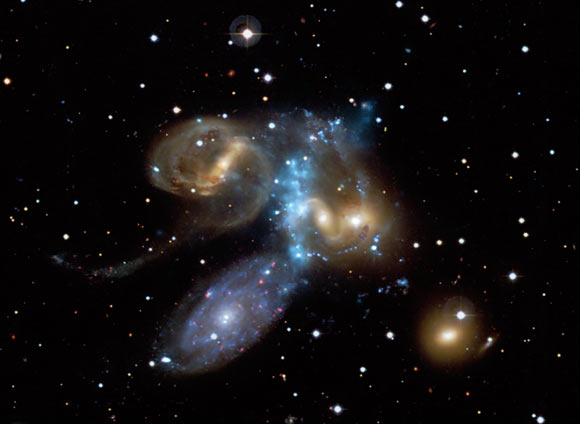A team of scientists using the Arecibo radio telescope measured the hydrogen content of 250 galaxies located in different environments to show that galaxies in groups have less gas than galaxies found in isolation.

This image shows Stephan’s Quintet – NGC 7317, NGC 7318a, NGC 7318b and NGC 7319 – a compact group of galaxies located about 280 million light years away. A prominent foreground galaxy called NGC 7320 is not a member of the group. Image credit: X-ray – NASA / CXC / CfA / E.O’Sullivan; optical – Canada-France-Hawaii-Telescope / Coelum.
“What drives the gas in and out of galaxies is one of the most outstanding open questions in extragalactic astronomy,” said Dr Barbara Catinella from Swinburne University of Technology, who is a lead author of the paper published in the Monthly Notices of the Royal Astronomical Society (arXiv.org).
Astronomers have known for decades that spiral galaxies located in clusters have less gas and star formation than similar, isolated galaxies. Clusters are much larger density concentrations, containing several hundred or even thousands of galaxies immersed in the so-called intergalactic medium.
“When a galaxy moves through this hot medium, most of its hydrogen gas can be easily removed,” said co-author Dr Luca Cortese of Swinburne University of Technology and European Southern Observatory.
“We know that gas is removed from galaxies that are located in the harsh cluster environment, but this is the first time that we witness similar effects in the more friendly groups. This was an exciting result, which opened up more questions than it solved.”
“It is unclear which physical process is responsible for the observed gas deficit in group galaxies. The milder intergalactic medium in groups might not suffice.”
Although observations of stars in galaxies do indicate that star formation is less efficient in groups, a clear link with the gas hadn’t been established until now.
“The observed decrease of gas content in the group environment would naturally explain why those galaxies are less efficient at forming stars. They are simply running out of fuel,” Dr Catinella said.
Future surveys of the gas content of galaxies will help astronomers to better characterize the still largely unknown group environment.
______
Bibliographic information: Barbara Catinella et al. 2013. The GALEX Arecibo SDSS Survey – VIII. Final data release. The effect of group environment on the gas content of massive galaxies. MNRAS 436 (1): 34-70; doi: 10.1093/mnras/stt1417







